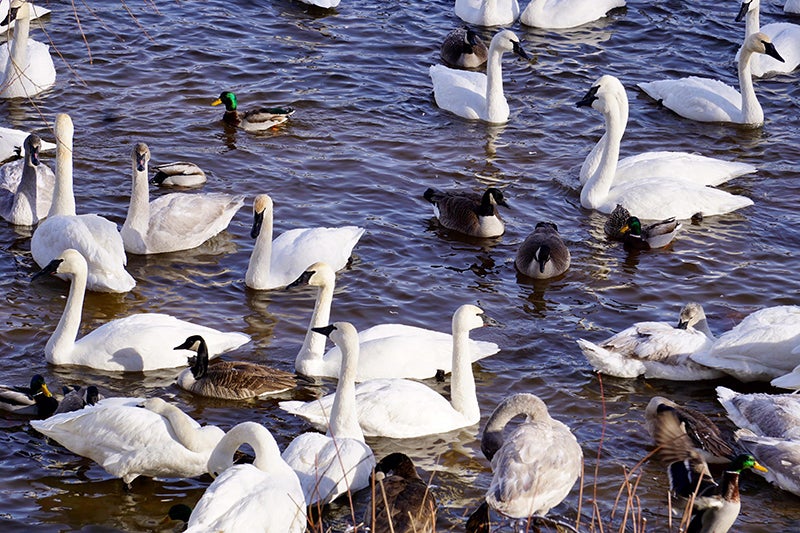Al Batt: Bird brains change seasonally to aid in finding own hidden food
Published 9:00 am Saturday, October 28, 2017

- Swans and ducks enjoy the water together. - Al Batt/Albert Lea Tribune
Al Batt of Hartland is a member of the Albert Lea Audubon Society. Email him at SnoEowl@aol.com.
My neighbor Crandall stops by.
“How are you doing?” I ask.
“Everything is nearly copacetic. I have to wear a pumpkin patch to battle my pumpkin spice addiction, but other than that, I’m swimming in gravy. I’m all ready for Halloween. I don’t buy any candy. I just put out empty bowls with a “take one” sign on each. My neighbor Scooter is giving out hamsters.”
“Hamsters?” I say.
“Why not? They’re small, furry and smell like bacon. Remember when we were trick-or-treating and found a wallet without any money in it and we returned it to the owner who didn’t know how to repay us? Besides being Halloween, Oct. 31 is also National Knock-Knock Jokes Day. Knock, knock.”
“Who’s there?” I ask.
“Etch.”
“Etch who?” I say.
“Gesundheit!”
Nature by the yard
There were two deer in the yard. They were drinking from a large bird waterer. They drink it dry. Not a drop of moisture would remain. It was as dark as 5 a.m. gets as our house cat Purl stared out the window at the deer. Her tail became bigger and bigger. I guess the appearance of deer is subject to interpretation.
Naturally
I saw a pair of sandhill cranes with two colts in Le Sueur County. Sandhill cranes mate for life and stay with their mates year-round. The colts, or juveniles, stick close to their parents for nine to 10 months after hatching. Each breeding pair typically has only one chick per year that survives to fledging, so it was nice to see two. The oldest sandhill crane on record was at least 36 years, 7 months old and banded in Wyoming in 1973.
I spotted two family groups of trumpeter swans at the Straight River Marsh in Steele County. One had five members and the other six. Young swans are called cygnets and often remain with their broodmates through their first year and may regroup with their parents at family wintering sites. Trumpeter swans are the largest native waterfowl in North America, stretching to 5 feet in length with an 8-foot wingspan and weighing as much as 30 pounds. The pair stays together throughout the year. Trumpeters are assumed to mate for life, but some do switch mates.
Q&A
“Why are there so many acorns this year?” An oak tree’s mast, or nut crop production, follows a boom and bust cycle. Oak trees do this in order to keep predators off balance. If they produced the same amount each year, there would be just enough predators to eat the entire acorn crop. By fluctuating the mast, the tree insures that some acorns will survive.
“How far south in Minnesota does the common loon nest?” Historically, our state bird bred throughout the state, as far south as the prairie region and into Iowa, although they were likely uncommon in the prairies. By 1900, loons nested in what is now central Minneapolis.
Today, breeding loons range across the northern two-thirds of the state. Five loon chicks were moved to Fish Lake, located in Le Sueur County, by Maine researchers in 2014. This lake is 78 acres in size and 55 feet at its deepest point. Nine young loons were transplanted from northern Minnesota lakes to Fish Lake in 2015. Loons need crystal-clear lakes, which makes it easy to see prey, with abundant populations of small fish.
“Do birds store food?” They do. Chickadees, nuthatches and blue jays are some of the birds that cache food. They hide food all over their territory in a behavior known as scatter-hoarding. This aids survival when food sources become scarce.
Neurobiologists found that the part of a bird brain that processes spatial information increases in the fall to help them recall where they’ve hidden food and then shrinks in the spring. Birds remember the location of each hidden goodie a month later.
Chickadees cache seeds, nuts and insects in knotholes, bark and under shingles typically within 100 feet from feeders. Nuthatches cache sunflower seeds in bark crevices within 45 feet of feeders. Blue jays cache acorns, peanuts and sunflower seeds. Jays are capable of carrying several nuts at a time and one jay can cache as many as 5,000 acorns by burying them in the ground up to 2.5 miles from their source.
A radio show
Please join me as I talk about nature at 10 a.m. every Tuesday morning on KMSU Radio. It’s 89.7 or 91.3 on the FM dial. It’s also available on TuneIn and SoundCloud.
The Pelican Breeze
My thanks to all the fine folks affiliated with the Pelican Breeze for their kind recognition party. It meant the world to me. I am proud to have been affiliated with that fine vessel for 21 years as it has floated on Albert Lea Lake.
Thanks for stopping by
“These mountains that you are carrying, you were only supposed to climb.” — Najwa Zebian
“If one thinks that one is happy, that is enough to be happy.” — Madame de La Fayette
Do good.


